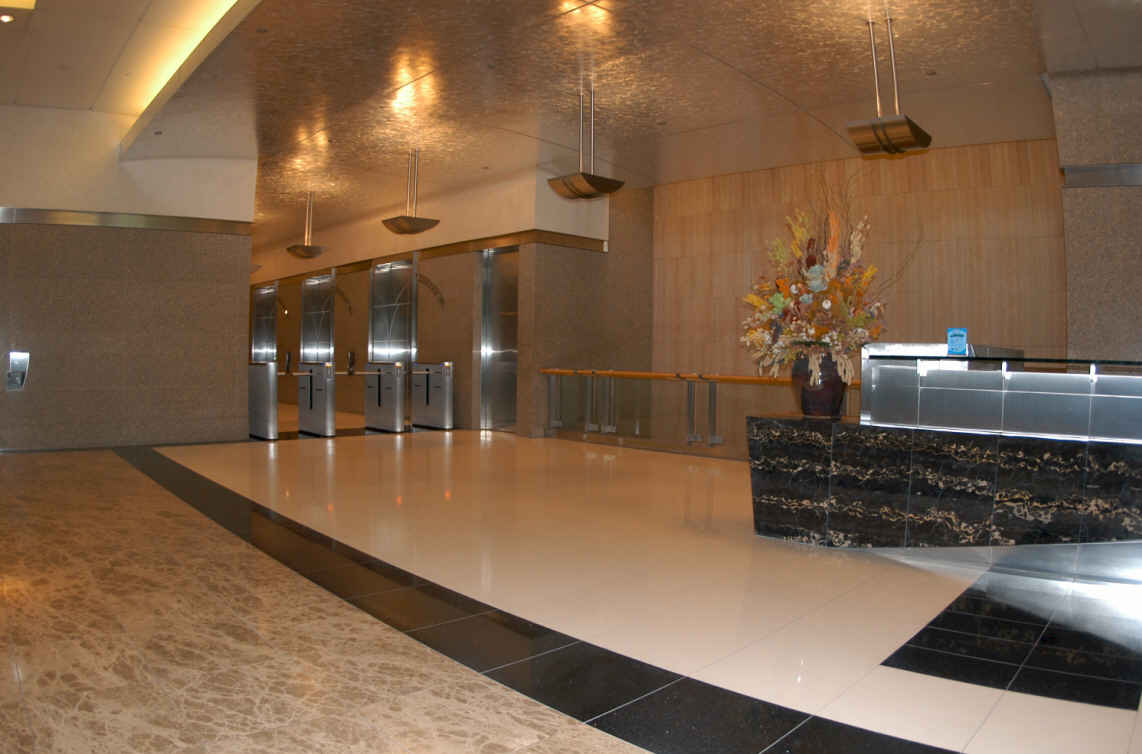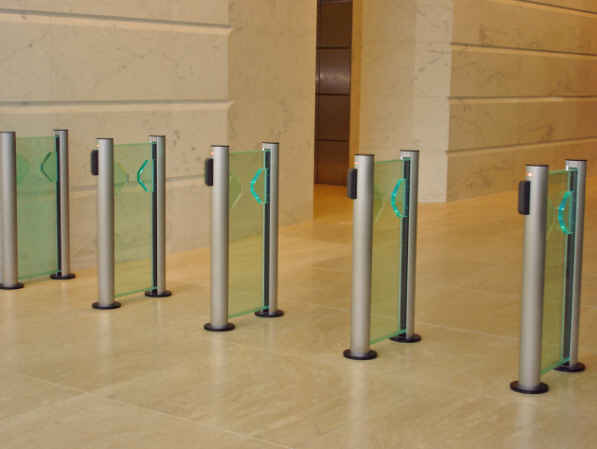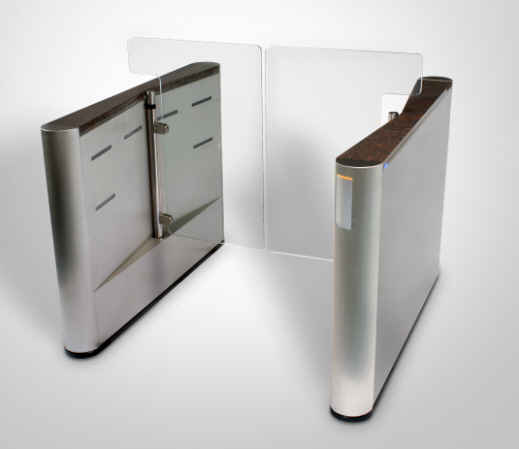By Michael Bystram
|

|
|
The demand for secure office buildings is growing and turnstiles play a key role in this. (Photo by Integrated Design Ltd.) |
The humble turnstile has been going through a revolution over the last 15 years as it has become an essential part of the frontline for an integrated security system for the modern office building.
The need in corporate offices is to provide employees with a safe environment to work in and to protect the assets and information within the building. Yet the entrance to a commercial facility must be aesthetically welcoming and easy for staff and visitors to use and security to manage.
Using turnstiles in the reception area of a building to create a secure perimeter just inside the building ensures only authorised people progress further in to the building.
As the turnstile has moved from the football stadium type application into the corporate office it has had to undergo some radical changes in design, technology and performance. No longer are we limited to the traditional tripod turnstile; now a whole myriad of choices are available to match the varying needs of a particular application. These choices vary in terms of the security level they provide, the aesthetic impact they have on the building and the rate at which they can process people.
WHAT’S AVAILABLE ON THE MARKET?
The following is a brief overview of the choices. Firstly there are the more traditional options.
1/2 Height Turnstiles
Typically used in a manned reception area, 1/2 height turnstiles provide a readily accepted form of tailgate deterrence. They offer acceptable speed of throughput combined with a medium level of security. However, a knowledgeable intruder climbing over or under the barrier can easily defeat them and often the aesthetics can prove to be unacceptable to some companies. Additionally a separate gate is required for disabled access. There is also a requirement to ensure the correct maintenance is done.
The trend in 1/2 height turnstiles has been towards improving the aesthetics by using a variety of materials such as glass, marble and wood in an attempt to blend in to the environment.
1/2 height turnstiles are a good option for office reception areas that are constantly manned and where aesthetics are not the highest requirement.
Full Height Turnstiles
Full height turnstiles provide a higher level of security than 1/2 height turnstiles and optical turnstiles, as they are impossible to jump over or crawl under. They can offer cost savings on guarding requirements, as there is no need to constantly man the area. However, their appearance and lower speed of throughput mean that they are more often used in areas where security is the prime requirement and not in reception areas. Additionally there is a separate requirement for disabled access.
Full height turnstiles are a good option for commercial and industrial facilities where security and guarding costs are more important than appearance. Even in this sector materials like Perspex and stainless steel are being used to minimise the aesthetic impact of a full height turnstile.
Security Booths
Security booths, sometimes called mantraps, offer the highest security level of all. An individual’s identity is checked before they are allowed in to a holding area. Once secured inside the holding area further checks can be made to ensure that they are by themselves and they offer no risk, via weight checks and metal detection for example. As the person is in a holding area they can easily be dealt with if they do present a possible threat. The high security nature of security booths makes them ideal for banks, military installations and hi-tech industries. Additionally they can often accommodate disabled users and provide safe emergency egress whilst their design can also offer a hi-tech, aesthetically acceptable appearance. However, they are very expensive, fairly slow, with high maintenance costs.
Security booths are a good option for use at unmanned areas with a high security requirement and relatively low traffic volumes. Additionally they can be used internally at high security areas such as computer rooms and cash handling areas.
Optical Turnstiles
|

|
|
Optical turnstiles provide the most discreet form of security. (Photo by Integrated Design Ltd.) |
These provide the most discreet form of security. The optical turnstile utilises infrared beams between pedestals to remove the need for the traditional barrier. They provide a similar level of security as a traditional 1_2height turnstile and can only be used in manned reception areas. In the event of an illegal entry a security guard is required to intervene and take the person to one side to be managed. However, as there is no barrier a far higher speed of throughput can be achieved -- typically 1 person per second. Additionally, the lack of barrier makes them easier to use, provides safe emergency egress and there is no requirement for a separate gate for disabled users. Also with no moving parts there is little maintenance requirement ensuring a fairly low cost of ownership. The open appearance created by optical turnstiles ensures aesthetic acceptance in most office environments where the overall design is important to create the correct image of a building.
Optical turnstiles are a good option for well managed, manned reception areas where ease of use, speed of throughput and aesthetic acceptability are prime requirements.
Speedgates
|

|
|
Speedgates are generating the biggest growth in sales currently and are forecast to continue to do so over the next few years. (Photo by Integrated Design Ltd.) |
Speedgates combine the best of optical turnstile and physical barrier technology, making them the very latest in high tech entrance control systems. This combination of technologies provides all the aesthetics and ease of use benefits unique to optical turnstiles with the added protection and deterrent effect that barriers provide.
There are typically 2 modes of operation for speedgates: Normally Closed or Normally Open. The choice of operation is normally based on a combination of how the building’s security is operated and also the design of the building.
Due to the combination of technologies, Speedgates are a good option for well managed, manned reception areas where there is a need to pay equal heed to security, ease of use, speed of throughput and aesthetic acceptability.
As building managers are demanding better looking products capable of providing faster throughput and greater security, it is the speedgate sector of the market that is set to show significant growth over the next 4 years.
It is also in the speedgate sector that technology has come in to play and this new technology offers clear advantages over the older type of systems.
Traditionally speedgates operated in one of 2 ways. Either they utilised very few IR beams linked to a simple PLC (Programmable Logic Controller). This worked on a simple logic basis. If you break beam A and then beam B then you must be going in and vice versa. Or they worked with a PLC and a shunt timer that disables the beams for a period of time after a card is presented.
The simple logic based system has no tolerance for beams being broken in the wrong order and can be prone to false alarms from people carrying umbrellas, briefcases, etc. The shunt based systems are inherently insecure as they are akin to closing your eyes whilst driving at 70 mph and hoping for the best when you open them again. These shunt type systems are prone to not detecting tailgaters effectively and false activations are apparent if people go through the lane slowly. Both types of systems are prone to false alarms if any of the beams are broken before a card is presented.
False alarms and activations in speedgates can result in users being hit by the barrier, so more intelligence in the detection technology was required.
TECHNOLOGY ADVANCEMENTS
The more advanced systems like the Fastlane Entrance Control range are based on multiple IR beams, typically creating a matrix linked to an advanced microprocessor with opinion-making software. The matrix of IR beams means there is more data for the processor to analyse. The IR beams are never turned off or shunted and the system makes an opinion about what it sees and whether it is a human or a smaller inanimate object such as a briefcase or umbrella. This allows the system to track multiple people through the lane simultaneously and make decisions about how fast people are moving. The end result of this kind of technology is an improvement in performance in 3 key areas: security, speed and safety.
As the system can track multiple people simultaneously it can detect tailgaters as close together as 5 mm, therefore reducing the risk of unauthorised people gaining access to the building.
Since the beams are not turned off or shunted there is no need to wait for the system to be re-engaged to allow the next person through, which can enable speeds of throughput of up to 1 person per second.
Finally, as the system is able to accurately position people in the lane and assess how fast they are moving it becomes possible to more accurately calculate when it is safe to open and close the barrier thereby reducing the chances of accidents occurring.
BEAUTY, SECURITY GO TOGETHER AT ENTRANCE
The demand for secure office buildings is growing and turnstiles play a key role in this. There are a number of options on the market to help balance the security, speed of throughput and cost needs of a business. One of the key requirements is the turnstiles’ architectural fit to the building as this is where the first impression of a building and the business it houses is made by both staff and visitors alike. It forms a key part of the corporate culture. Of the options available, speedgates are generating the biggest growth in sales currently and are forecast to continue to do so over the next few years. The reasons contributing to this include the architectural flexibility of speedgates, their use of modern materials like glass and stainless steel to help them blend in with building designs as well as the state of the art technology currently being employed to give superior performance.
Michael Bystram is Sales & Marketing Manager of Integrated Design Ltd. (www.idl.co.uk).
For more information, please send your e-mails to swm@infothe.com.
ⓒ2007 www.SecurityWorldMag.com. All rights reserved.
|



